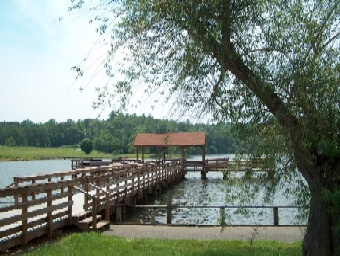
Charlottesville 365; Geocache a Treasure! (Beginning at Chris Greene Lake, Charlottesville)

Hide N Seek
As a child I dreamed of finding a lost treasure map that would lead me to a cache of gold. Maybe that’s the reason I love “Goonies” so much; it would have been a dream come true for me. I never found that map, but as an adult I did find geocaching—a high-tech treasure-hunting game. Geocaching (pronounced geo-cashing) is played throughout the world; in fact there are more than 1 million active caches in the world and close to 100 within 10 miles of 22901. An estimated 3-4 million people geocache.
What is it?
People hide containers—called geocaches—outdoors, marking the location using GPS technology and then share their experiences online at http://www.Geocaching.com. The most important piece of equipment is a hand-held GPS (ones in the car won’t work…you need to have one to carry into the woods with you). It doesn’t have to have all the bells and whistles and cost a fortune. You can get a really good one for about $150 that works perfectly for geocaching.
The basic idea is to locate the hidden containers—geocaches. Geocaching is enjoyed by people from all age groups, with a strong sense of community and support for the environment. One aspect stressed in geocaching is Cache In Trash Out (CITO) in case you see that on the website. Anyone can go on hunts; age is not a factor. There are easy ones, and then there are more difficult ones which might require special equipment.
As a family we have participated in geocaching since the early 2000s. The kids have gone on hunts since they were under 5 each, and the dogs love to see me grab the geocaching bag and dog leashes.
First Step
Visit the geocaching website to set up a free account. I’m Mountain Chick if you see my logs online. Explore the site to learn the symbols and the rankings, such as a 1 for difficulty and a 1 for terrain means it’s going to be an easy find for anyone. A 5 for difficulty could indicate a multi-cache puzzle and a 5 for terrain could mean it’s in the center of a lake and you’ll need a boat to get there. I’d recommend working up to the most difficult ones.
In our area, Chris Greene Lake Park in Albemarle County has a myriad of choices. This would be a great start for any geocaching novice as there are at least 8 hidden treasures in this park. One is multi-part puzzle hidden for the 10 Years of Geocaching Celebration held May 1. One requires a watercraft to get to the opposite side of the lake (you don’t want to brave the poison ivy) and one is a Letterbox hybrid that can be done as a multi-part cache with a GPS. (Letterboxing is similar to geocaching without a GPS—visit http://www.letterboxing.org for more information on that). I have personally found several of these at Chris Green Lake and I’m thinking a trip is necessary in the near future to find the others, too.
Get Set
You’re ready—you have the GPS, the account on the website and the beautiful day—now get set. On the website, under Hide & Seek a Cache type in your zip code (anywhere on the planet) and a list of nearby geocaches will pop up. Figure out the ones you want to seek based on location and difficulty and head out. There are often special events, too. You can set up to receive emails once a week (sooner for premium memberships) so you know of new ones hidden nearby and special events like the one at Chris Greene Lake in advance.
What to Bring
I have a GPS bag that contains these items all the time so when we’re ready to go I just need to grab the bag and head out. You should bring water, snacks, extra clothing (if you’re headed out near water—especially important if you have children like mine who love to play in creeks), a pen, extra batteries for the GPS and items to place in the cache. Once you find the geocache you might want to exchange something you have for something in the container. After being the first to find the geocache, this is my children’s favorite part (who doesn’t love something new?). We carry little toys around, perhaps little bottles of bubbles, and the numerous fast-food toys we have are great to exchange.
Logs
Each cache has a log book (hence the need for the pen). Sign each log and then when you go home you connect to the website again to log the visit. If there are things the cache owner needs to know, such as someone unearthing the container and not putting it back, log that on the website. In the log let people know what you took and what you left and if you took photos, add those too.
These are just the basics to geocaching. There are so many options and aspects to the hunt you’ll need to learn for yourself. Enjoy!
We look forward to hearing about your geocaching adventures! Have you been geocaching locally?
To check out geocaching online, visit; http://www.Geocaching.com
A map to Chris Greene Lake, a great location for geocache beginners;
[mappress]


There are 2 Comments in this post
That is a very nice page on geo cashing and covers all of it!!!!
Thanks so much for the feedback, Juliet! Terry did a really nice job on this, I agree!